Kyōto Station
Kyoto Station 京都駅 | |
 | |
|---|---|
| Kyoto Station Building (Karasuma side) | |
| Location | |
| Prefecture | Kyoto (See other stations in Kyoto) |
| City | Kyoto |
| Ward | Shimogyo |
| (in Japanese) | 京都市下京区 |
| Rail services | |
| Operator(s) | JR West, JR Central, Kintetsu, Kyoto Municipal Subway |
| Statistics | 239.6 million passengers/year (2012)[1] |
Kyoto Station (京都駅 Kyōto-eki) is a major railway station and transportation hub in Kyoto, Japan. It has Japan's second-largest station building (after Nagoya Station) and is one of the country's largest buildings, incorporating a shopping mall, hotel, movie theater, Isetan department store, and several local government facilities under one 15-story roof. It also housed the Kyoto City Air Terminal until August 31, 2002.
History
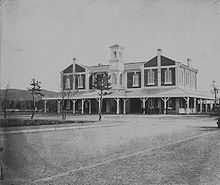
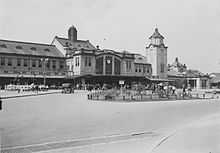
_Kyoto%2CJAPAN.jpg)
The governmental railway from Kobe reached Kyoto on September 5, 1876, but the station was under construction and a temporary facility called Ōmiya-dōri (Ōmiya Street) Temporary Station was used until the opening of the main station. The first Kyoto Station opened for service by decree of Emperor Meiji on February 5, 1877.[2]
In 1889, the railway became a part of the trunk line to Tokyo (Tokaido Main Line). Subsequently the station became the terminal of two private railways, Nara Railway (1895, present-day Nara Line) and Kyoto Railway (1897, present-day Sagano Line), that connected the station with southern and northern regions of Kyoto Prefecture, respectively.[3]
The station was replaced by a newer, Renaissance-inspired facility in 1914, which featured a broad square (the site of demolished first station) leading from the station to Shichijō Avenue. Before and during World War II, the square was often used by imperial motorcades when Emperor Showa traveled between Kyoto and Tokyo. The station was spacious and designed to handle a large number of people, but when a few thousand people gathered to bid farewell to naval recruits on January 8, 1934, 77 people were crushed to death. This station burned to the ground in 1950, and was replaced by a more utilitarian concrete facility in 1952.
The current Kyoto Station opened in 1997, commemorating Kyoto's 1,200th anniversary. It is 70 meters high and 470 meters from east to west, with a total floor area of 238,000 square meters. Architecturally, it exhibits many characteristics of futurism, with a slightly irregular cubic façade of plate glass over a steel frame. The architect was Hiroshi Hara.
Kyoto, one of the least modern cities in Japan by virtue of its many cultural heritage sites, was largely reluctant to accept such an ambitious structure in the mid-1990s: The station's completion began a wave of new high-rise developments in the city that culminated in the 20-story Kyocera Building.
Aside from the main building on the north side of the station, the Hachijō-guchi building on the south side was built to house Tokaido Shinkansen which started operation in 1964. The underground facilities of the station, including the shopping mall Porta beneath the station square, were constructed when the subway opened in 1981.
Lines
Kyoto Station is served by the following railway lines:
- Central Japan Railway Company (JR Central)
- Tokaido Shinkansen
- West Japan Railway Company (JR West)
- Tokaido Main Line (Biwako Line and JR Kyoto Line)
- Sanin Main Line (Sagano Line)
- Nara Line
- Kintetsu
- Kyoto Municipal Subway
In addition to the lines above, the following lines, among others, have through services to Kyoto Station:
- JR West
JR West / JR Central
| JR | |
Kyoto Station 京都駅 | |
 | |
|---|---|
| Hachijō-side building of Kyoto station | |
| Location | |
| Prefecture | Kyoto |
| City | Kyoto |
| Ward | Shimogyō |
| Neighborhood etc. | 901 Higashi-Shiokōjichō (JR West) 8-3 Higashi-Shiokōji Takakura-chō (JR Central) |
| Coordinates | 34°59′7.65″N 135°45′27.92″E / 34.9854583°N 135.7577556°E |
| Postal code | 600-8212 (JR West) 600-8214 (JR Central) |
| (in Japanese) | 京都市下京区東塩小路町901(JR西日本) 京都市下京区東塩小路高倉町8-3(JR東海) |
| History | |
| Year opened | 1877 |
| Rail services | |
| Operator(s) | JR West JR Central |
| Line(s) | Tokaido Shinkansen (JR Central) Tokaido Line(Biwako Line, JR Kyoto Line), Nara Line, Sanin Line (Sagano Line) (JR West) |
| Statistics | 162.7 million passengers/year (2012)[1] |
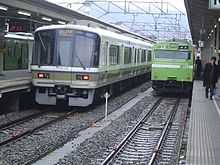
Layout
The station has a side platform and four island platforms serving eight tracks for the Tokaido Line (Biwako Line, JR Kyoto Line) and Kosei Line at ground level, three dead-end platforms serving four tracks for the Sanin Line (Sagano Line) to the west of platform 0 at ground level, and two dead-end platforms serving 3 tracks to the south of platform 7 at ground level. Two island platforms serving four tracks for the Shinkansen are elevated, above the platforms for the Kintetsu Kyoto Line.
| 0 | ■Hokuriku Line limited express trains | for Fukui, Kanazawa, and Toyama |
| ■Tokaido Line, Chuo Line, Takayama Line limited express trains | for Maibara, Nagano, and Takayama | |
| ■Biwako Line | part of special rapid trains for Kusatsu and Maibara on weekday mornings | |
| ■Kosei Line | part of special rapid trains for Katata and Ōmi-Imazu on weekday mornings | |
| ■Kusatsu Line | for Kibukawa and Tsuge (evening, night) | |
| 2, 3 | ■Biwako Line | for Kusatsu and Maibara |
| ■Kosei Line | for Katata and Ōmi-Imazu | |
| 4, 5 | ■JR Kyoto Line | for Ōsaka and Sannomiya |
| 6, 7 | ■Kinokuni Line limited express trains Kuroshio | for Shirahama and Shingū |
| ■Chizu Express Line limited express trains Super Hakuto | for Tottori and Kurayoshi | |
| ■Kansai Airport Line limited express trains Haruka | from Maibara and Kusatsu for Kansai Airport | |
| ■limited express trains from the Hokuriku Line, Tokaido Line | for Osaka | |
| ■JR Kyoto Line | rapid trains and special rapid trains for Osaka and Sannomiya in the morning | |
| 8, 9, 10 | ■Nara Line | for Uji and Nara |
| 30 | ■Kansai Airport Line limited express trains Haruka | for Kansai Airport |
| ■Sagano-Sanin Line limited express trains (partly) | for Fukuchiyama, Kinosaki Onsen, Higashi-Maizuru, and Amanohashidate | |
| 31 | ■Sagano-Sanin Main Line limited express trains | for Fukuchiyama, Kinosaki Onsen, Higashi-Maizuru, and Amanohashidate |
| ■Sagano-Sanin Line | part of trains for Kameoka, Sonobe, and Fukuchiyama | |
| 32, 33 | ■Sagano-Sanin Line | local trains and rapid trains for Kameoka, Sonobe, and Fukuchiyama |
| 34 | ■ Disembarking only for trains at platform 33 | |
| 11, 12 | ■Tokaido Shinkansen | for Nagoya and Tokyo |
| 13, 14 | ■Tokaido Shinkansen | for Shin-Osaka and Hakata |
| Hachijō side (South) | ||
| Brown (2 tracks): Nara Line to Uji and Nara | ||
| Blue (4 tracks): Tōkaidō Main Line (Biwako Line) to Maibara, Nagoya and Tokyo Kosei Line to Omi-Imazu and Tsuruga |
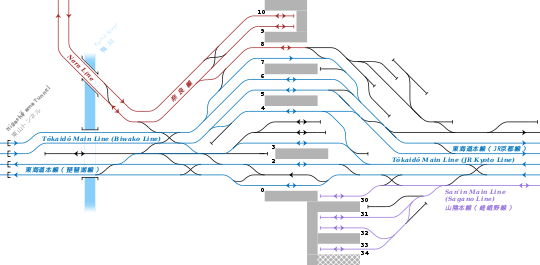 |
Black (1 track): Freight Line to Kyoto Freight Station |
| Blue (4 tracks): Tōkaidō Main Line (JR Kyōto Line) to Ōsaka and Kōbe | ||
| Purple (1 track): San'in Main Line (Sagano Line) to Fukuchiyama | ||
| Karasuma Side (North) |
Limited express trains
- for the Hokuriku Line
- limited express Thunderbird: Osaka - Kanazawa, Toyama, Uozu, Wakura Onsen
- for the Tokaido Line, the Chūō Line, and the Takayama Line
- limited express Shinano: Osaka - Nagano
- limited express Hida: Osaka - Takayama
- limited express Biwako Express: Osaka - Maibara
- for the Sanin region via the Chizu Express Chizu Line
- limited express Super Hakuto: Kyoto - Tottori, Kurayoshi
- for the Hanwa Line, Kansai Airport Line and the Kinokuni Line
- Kansai Airport limited express Haruka: Maibara, Kyoto - Kansai Airport
- limited express Kuroshio: Kyoto, Shin-Osaka - Shirahama, Shingu
- for the Sanin Line, the Maizuru Line and the Kitakinki Tango Railway lines
- limited express Kinosaki: Kyoto - Fukuchiyama, Toyooka, Kinosaki Onsen
- limited express Hashidate: Kyoto - Miyazu, Amanohashidate, Toyooka
- limited express Maizuru: Kyoto - Higashi-Maizuru
Adjacent stations
| « | Service | » | ||
|---|---|---|---|---|
| Tokaido Shinkansen | ||||
| Nagoya | Nozomi | Shin-Osaka | ||
| Maibara | Hikari | Shin-Osaka | ||
| Maibara | Kodama | Shin-Osaka | ||
| Tokaido Line (Biwako Line, JR Kyoto Line), Kosei Line | ||||
| Yamashina | Special Rapid | Takatsuki | ||
| Yamashina (local) | Rapid (mornings) | Nagaokakyō (rapid) | ||
| Yamashina | Local (JR Kyoto Line daytime rapid) | Nishiōji | ||
| Nara Line | ||||
| Terminus | Miyakoji Rapid | Tōfukuji | ||
| Terminus | Rapid | Tōfukuji | ||
| Terminus | Regional Rapid | Tōfukuji | ||
| Terminus | Local | Tōfukuji | ||
| Sagano Line (Sanin Line) | ||||
| Terminus | Rapid | Nijō | ||
| Terminus | Local | Tambaguchi | ||
Kintetsu
| Kintetsu | |
Kyoto Station 京都駅 | |
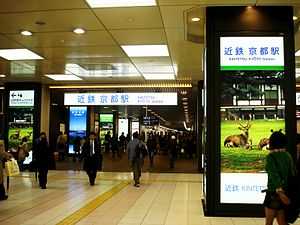 | |
|---|---|
| Location | |
| Prefecture | Kyoto |
| City | Kyoto |
| Ward | Shimogyō |
| Neighborhood etc. | 31-1 Higashi-Shiokoji Kamadonochō |
| Coordinates | 34°59′4.82″N 135°45′27.05″E / 34.9846722°N 135.7575139°E |
| Postal code | 600-8215 |
| (in Japanese) | 京都市下京区東塩小路釜殿町31-1 |
| History | |
| Year opened | 1928 |
| Rail services | |
| Operator(s) | Kintetsu Corporation |
| Line(s) | Kintetsu Kyoto Line |
| Statistics | 36.9 million passengers/year (2012)[1] |
Layout
The station has three levels. Four dead-end platforms serving four tracks are located on the second floor. The 1st floor is a shopping street and the 3rd is the platforms for the Shinkansen (JR Central).
| 1, 2 | ■Limited express trains | for Nara, Kashiharajingu-mae, Ise-Shima |
| 1, 2, 3, 4 | ■Local trains and express trains | for Tambabashi, Shin-Tanabe, Yamato-Saidaiji, Nara, Tenri, Kashiharajingu-mae |
Adjacent stations
| « | Service | » | ||
|---|---|---|---|---|
| Kyōto Line | ||||
| Terminus | Local | Tōji | ||
| Terminus | Semi-Express (only in the morning on weekdays) | Tōji | ||
| Terminus | Express | Tōji | ||
| Terminus | Limited Express | Kintetsu-Tambabashi | ||
Kyoto Municipal Subway
| Kyoto Municipal Subway | |
Kyoto Station 京都駅 | |
| Location | |
|---|---|
| Prefecture | Kyoto |
| City | Kyoto |
| Ward | Shimogyō |
| Neighborhood etc. | Higashi-Shiokōji |
| Coordinates | 34°59′7.97″N 135°45′36.44″E / 34.9855472°N 135.7601222°E |
| (in Japanese) | 京都市下京区東塩小路 |
| History | |
| Year opened | 1981 |
| Rail services | |
| Station number(s) | K11 |
| Operator(s) | Kyoto Municipal Subway |
| Line(s) | Karasuma Line |
| Statistics | 40.0 million passengers/year (2012)[1] |
Layout
The station consists of one underground island platform serving two tracks.
| 1 | ■Southbound trains | for Takeda, the Kintetsu Kyoto Line (Shin-Tanabe, Nara) |
| 2 | ■Northbound trains | for Shijō, Karasuma Oike, Kokusaikaikan |
Adjacent stations
| « | Service | » | ||
|---|---|---|---|---|
| Karasuma Line (K11) | ||||
| Gojō (K10) | - | Kujō (K12) | ||
Surroundings
Karasuma Gate

- Kyoto Station Building
- JR Kyoto Isetan
- Kyoto Station Shopping street "The Cube"
- Hotel Granvia Kyoto
- Kyoto Gekijo
- Museum of Art "Eki" Kyoto
- Kyoto Station Underground Mall "Porta"
- Kyoto-Yodobashi
- Hotel New Hankyu Kyoto
- Kyoto Tower
- Higashi Hongan-ji
- Shimogyo-ku General Building
- Campus Plaza Kyoto
- Kyoto Central Post Office
- Omron
- Kyoto Bus Station
Nishinotoin Gate
- Bic Camera JR Kyoto Station (JR Kyoto Station NK Building)
Hachijo Gate
- Hotel Kintetsu Kyoto Station
- Kyoto Avanti
- Hotel Keihan Kyoto
- Sightseeing Bus Terminal
- Expressway Bus Terminal
- New Miyako Hotel
- To-ji
- ÆON Mall Kyoto
- PHP Institute
References
- ↑ 1.0 1.1 1.2 1.3 "第8章 都市施設" [Chapter 8: Urban facilities]. 京都市統計書 [Statistics of Kyoto City] (in Japanese). City of Kyoto. 2014.
- ↑ Ishino, Tetsu et al. (eds.) (1998). 停車場変遷大事典 国鉄・JR編 [Station Transition Directory - JNR/JR] (in Japanese). Tokyo: JTB Corporation. p. 34, vol. II. ISBN 4533029809.
- ↑ Ishino, supra, pp. 298, 351
- ↑ "JR Nishinihon Tōkaidō Honsen Maibara–Kōbe kan Senro Haisen Ryakuzu". Japan Railfan Magazine (in Japanese) (Kōyūsha) (January 2008, No. 561): inserted sheet between pp. 34–35.
- ↑ Kawashima, Ryōzō (2009). Tōkaidō Rain Zensen Zen'eki Zen-Haisen vol. 6 (Maibara eki–Ōsaka eria) (in Japanese). Kōdansha. pp. 17–18. ISBN 978-4-06-270016-0.
External links
| Wikimedia Commons has media related to Kyoto Station. |
- Official website - Kyoto Station Building Development
- Station map by West Japan Railway
- Station map by Kintetsu Corporation
- Station map by City of Kyoto
Coordinates: 34°59′07″N 135°45′30″E / 34.985407°N 135.758450°E